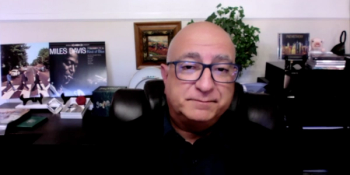
- October 2021
- Volume 27
- Issue 7
Dr David S. Hong: We Are Learning Every Day About Cellular Therapies
Gavo-cel (gavocabtagene autoleucel; TCR2 Therapeutics) is currently being investigated for use against mesothelin overexpression in 4 types of solid tumor cancers: malignant mesothelioma, ovarian cancer, cholangiocarcinoma, and non–small cell lung cancer (NSCLC). Data, first presented at this year’s American Association of Cancer Research (AACR) annual meeting, showed a single intravenous (IV) infusion of the engineered cellular therapy produced a 100% disease control rate (DCR) and 61% target lesion regression rate (TLR) in 7 evaluable patients: 6 with malignant mesothelioma and 1, ovarian cancer.1
In an update presented at European Society for Medical Oncology 2021 Congress, from the phase 1/2 dose-escalation trial examining gavo-cel, data were presented on 17 patients evaluated for safety—12 with malignant mesothelioma, 4 with ovarian cancer, and 1 with cholangiocarcinoma—all of whom again received a single IV gavo-cel infusion (16 patients were evaluated for efficacy). Results were still robust for both measures, but lower: 92% and 24%, respectively.2
In an interview with Evidence-Based Oncology™ (EBO), lead author David S. Hong, MD, professor and deputy director, Department of Investigational Cancer Therapeutics, and associate vice president of clinical research, The University of Texas MD Anderson Cancer Center, discussed these newest data, why mesothelin is such an attractive target for precision treatment, and next steps in the gavo-cel investigation.
This interview has been edited slightly for conciseness and clarity.
EBO: Phase 1 data on gavo-cel were presented in April at the AACR annual meeting. With this interim update of phase 1/2 data presented at ESMO Congress 2021, will you tell us about the dose-escalation results you have seen and how they build on previous findings?
HONG: A couple of things. This is an expansion of what we presented in April—we now have 16 evaluable patients on the trial—at that time, the overall response rate was about 50%.
The overall investigator response rate now, by the independent group, is around 38% have a confirmed response rate. So, some difference. We expect that there’s going to be some decrease in the actual response rate as you expand these studies, but still a very robust response rate in this really heavily pretreated patient population of mesothelioma, ovarian cancer, and cholangiocarcinoma.
The overall toxicity profile has not really significantly changed from what we saw in April. Overall, it’s a very encouraging study. We’ll see as we go into the expansion, and see more patients, if we can maintain that really robust response rate. We’re really encouraged by that.
EBO: Can you explain the process behind delivering gavo-cel, particularly the use of an antimesothelin antibody lentiviral vector, as well as why lentiviral vectors are an appropriate vehicle for anticancer gene therapies?
HONG: I think mesothelin is a unique target. There are very few antigens that you can target, independent of human leukocyte antigen, that are, to a large extent, expressed on tumors and have very or limited expression on normal tissue. We know that mesothelin is highly expressed, obviously in malignant mesothelioma, but it’s also expressed in a number of very common tumor types: NSCLC, cholangiocarcinoma, and ovarian cancer. Even to some extent, pancreatic cancer. So I think that was the reason that they used mesothelin as a target.
Gavo-cel is a unique platform. CAR Ts [chimeric antigen receptor T cells], in and of themselves, have not shown a whole lot of activity in solid tumors. We obviously know the success of CD19-based cellular therapies and CAR T in lymphomas and leukemias, but if you look at some of the cellular therapies that have been in existence for many, many years, CAR Ts have not been gangbusters. There’s not an approved cellular therapy right now in solid tumors. But TCRs [T-cell receptors] seem to have more robust activity in solid tumors, and there’s a lot of different reasons for that.
Gavo-cel—and TCR2 Therapeutics—is trying to take the advantage of TCRs, relatives of CAR Ts. They reengineer these T cells, really to bind the epsilon chain of these TCR receptors that then can be called HLA independent yet bind mesothelin, which is damaged and obviously that is overexpressed in a lot of tumors.
Why lentiviral vectors? I think, to a large extent, partly because that technology has probably been validated most with many of the different ways that we are constructing these platforms with these cellular therapies. That’s been just the most straightforward way to do it. I know there are other technologies trying to look at that, but I think that’s to a large extent why that’s been implemented: because it’s been something that’s been proven.
EBO: Is overexpression of mesothelin the singular fact that that contributes to gavo-cel’s success against solid tumor or are there other reasons?
HONG: There’s a threshold we have to meet for these patients to be on the trial. The numbers are small—16 evaluable patients. The analysis that we’ve done so far, it’s too early for us to tell if you have 100% mesothelin expression, you’re going to have a better response than if you had 30% mesothelin expression, for example. That makes sense. But there have been other cellular therapies, other than mesothelin, where the nuances of whether a patient responds, based upon antigen expression, really hasn’t panned out. I suspect there are lots of different variables that we’re still trying to figure out, whether it’s overexpression level, whether these cells persist in the body.
There are probably other factors that we haven’t identified that may kind of tweak which patients may actually benefit vs not. I do think that we will figure those things out, that those things will eventually emerge, and maybe even to the point where TCR2 or any other companies that decide to move into larger phase 3 trials, we’ll figure that out. But right now it’s not really clear whether or not just expression in itself is the main driver for response.
EBO: How does lymphodepletion contribute to precision oncology treatment success?
HONG: In general, we use lymphodepletion just like we use an autologous bone marrow transplantation: to allow for continued survival in that host body. This trial is interesting. The FDA required the first patient to not get lymphodepletion as we were escalating. And then following that, after a period of time the following patients had to be lymphodepleted. Interestingly enough, we saw some tumor regression independent of lymphodepletion. Clearly, those patients who had had lymphodepletion responded well, and that’s probably because the cells were able to evade the natural immune system better with lymphodepletion and were able to persist in the body longer because of lymphodepletion. That’s the primary reason why we do lymphodepletion, in general.
EBO: These data also address an additional indication for gavo-cel, in cholangiocarcinoma. What do the 3 solid tumor cancer types for which use of gavo-cel is being investigated—mesothelioma and ovarian cancer, as well—have in common that make them appropriate targets for treatment with gavo-cel?
HONG: They all expressed mesothelin. Obviously, mesothelin is highly expressed in mesothelioma. Interestingly enough, also in ovarian cancer and cholangiocarcinoma—not to the extent that mesothelioma patients have it, but a fairly high percentage of ovarian cancer and cholangiocarcinoma patients have high expression of mesothelin. So that’s to a large extent why we chose those patients. There’s a prescreening process that occurs with all of these patients, and the reason we narrowed this is so that we’re not prescreening 1000 patients and you get 1 patient out of it. You want to prescreen patients that you think are going to have high expression of mesothelin. So that’s why we chose ovarian, cholangiocarcinoma, and mesotheliomas.
EBO: Do patients need to have exhausted all previous treatment options or could gavo-cel eventually be a first-line choice?
HONG: That’s a question that is hard to answer right now. I think, in general, patients who have had less prior therapies will eventually do better with immunotherapy. We know that with checkpoint inhibitors. I think that may pan out for other cellular therapies, too, whether gavo-cel or other patients. Just how drug development works, as you all know, these patients have frontline options that we know have survival benefit; particularly in many of these types of tumors, it’s standard chemotherapy. My guess is that if gavo-cel continues to show this robust response, it’s a high indication that it will likely work in the refractory setting and there’s a good chance that it will work as you go up the lines of prior therapy, where at some point we may be able to compare this with standard-line therapy. But I think that it’s just way too early for us to know right now.
EBO: The fourth investigative indication for gavo-cel is NSCLC. Overall, lung cancer is notoriously diagnosed at advanced stages because the symptoms often mask other conditions. In this regard, is a precision treatment such gavo-cel meant to be curative or improve quality of life for the remaining time a patient may have?
HONG: Right now, it’s a phase 1 study. I think the hope is that all cellular therapies down the line will lead toward…at least prolonged remission and prolonged benefit in these patients, like NSCLC. I don’t think right now we are under any illusion that this is going to lead to cures right now in NSCLC refractory to immunotherapy and chemotherapy. But if response rates pan out as we have seen in mesothelioma and ovarian cancer, I do think that there’s a good chance that there will be a benefit in chemorefractory NSCLC. In many of the patients that we did treat with gavo-cel who did respond, they were refractory already to checkpoint inhibitor therapy. Most patients with NSCLC will have received some kind of checkpoint inhibitor therapy.
As of the report of the 16 patients, we did not include any NSCLC patients as I recall, but I don’t see why we couldn’t see similar benefit in those patients.
EBO: Will you be looking at gavo-cel in a larger cohort?
HONG: We’re almost at the recommended phase 2 dose. I think we’re going to launch, once we do expansion, an amend to this as a phase 2 portion in each of these different tumor types. There are a number of other combinations that we’re going to look at down the line, whether it’s with checkpoint inhibitors or with other possible combinations that hopefully would augment these cells. I’m sure we’re going to try to present something next year, maybe an update to this, but also maybe share additional data on combinations.
I just want to say that cellular therapy in solid tumors is an exciting area that is eventually going to emerge, like checkpoint inhibitors in solid tumors. The technologies still have a long way to go, but I think what’s exciting is these technologies can be tweaked. We are learning every day. Every patient we put on we try to understand why that patient responded vs not, why those patients have certain toxicities vs not. And I think we’ll learn.
Also, just the people I’ve met, not only at TCR2, but other companies, they are just brilliant. I take care of the patients and help design the clinical trials, but the people who actually developed this technology are some of the brightest people I’ve met. I’m optimistic that we will find that this fact these kinds of platforms and these cellular therapies will work in patients and in our cancer patients. And hopefully we’ll be able to scale it so that community physicians and other physicians can give it just like I give it in MD Anderson.
References
1. Hong DS, Johnson M, Tanyi JL, et al. Preliminary safety and efficacy of gavocabtagene autoleucel (gavo-cel, TC-210), a T cell receptor fusion construct (TRuC), in patients with treatment refractory mesothelin overexpressing solid tumors. Presented at: AACR Annual Meeting; April 10-15 and May 17-21, 2021. Abstract CT105.
2. Hong DS, Johnson M, Tanyi JL, et al. Gavocabtagene autoleucel (gavo-cel, TC-210) dose escalation in refractory mesothelin-expressing solid tumors. Presented at: ESMO Congress 2021; September 16-21, 2021. Poster 9590. https://bit.ly/39T1czF
Articles in this issue
about 4 years ago
From the Editor-in-Chief: The Way Upabout 4 years ago
Building a Patient-Centered Cancer Center From the Ground Upabout 4 years ago
The Promise of Liquid Biopsies for Cancer DiagnosisNewsletter
Stay ahead of policy, cost, and value—subscribe to AJMC for expert insights at the intersection of clinical care and health economics.





























































